Warning lights in the car are every driver’s nightmare.
While some of these dashboard lights are harmless causes that you can fix on your own in a few seconds (such as the low fuel indicator), other warning lights (the famous check engine light) illuminate only when there is a more severe problem.
In this article, we’ll show you the 19 most essential warning lights on your car dashboard, tell you the possible causes, and give you tips on how to act correctly.
According to a survey, 59 percent of respondents need help correctly classifying car warning signs. Unfortunately, after this post, you’re guaranteed not to be one of them!
Let’s go!
Tip: If you are looking for a specific light on your dashboard, use the table of contents below to jump directly to the appropriate location.
Advertising links are marked with *. We receive a small commission on sales, nothing changes for you.
#1: Oil Pressure Warning Light
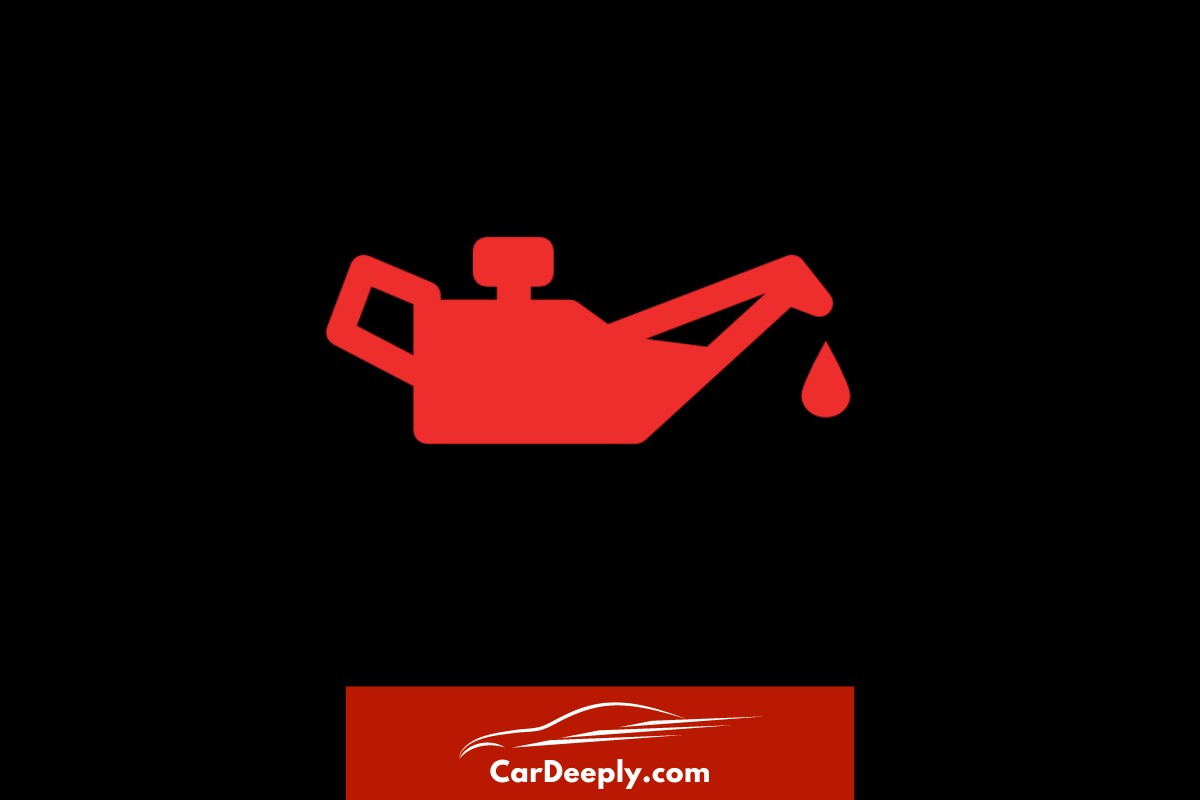
Ah, the suitable old Oil Pressure Warning Light!
It’s essential to pay attention to this little gem. This light typically shows an oil can icon or the word “OIL” and comes on when there’s a drop in your engine’s oil pressure.
Possible causes for the Oil Pressure Warning Light
- Low oil level: You might be running low on engine oil.
- Faulty oil pressure sensor: Sometimes, the sensor itself could be the issue.
- Oil pump failure: The pump responsible for circulating oil might be failing.
- Clogged oil filter: Debris could be restricting oil flow.
What to do when you see an oil pressure warning?
- Safely pull over and turn off your engine. Running with low oil pressure can cause severe damage.
- Check the oil level using the dipstick or your car function in the cockpit. If it’s low, top it off with the recommended oil.
- If the oil level is okay, but the light persists, it’s time to visit your trusty mechanic for a proper diagnosis.
Remember, your car’s engine is like its heart, and oil is its lifeblood. So, watch that Oil Pressure Warning Light and treat it with respect!
#2: Engine Temperature Warning Light
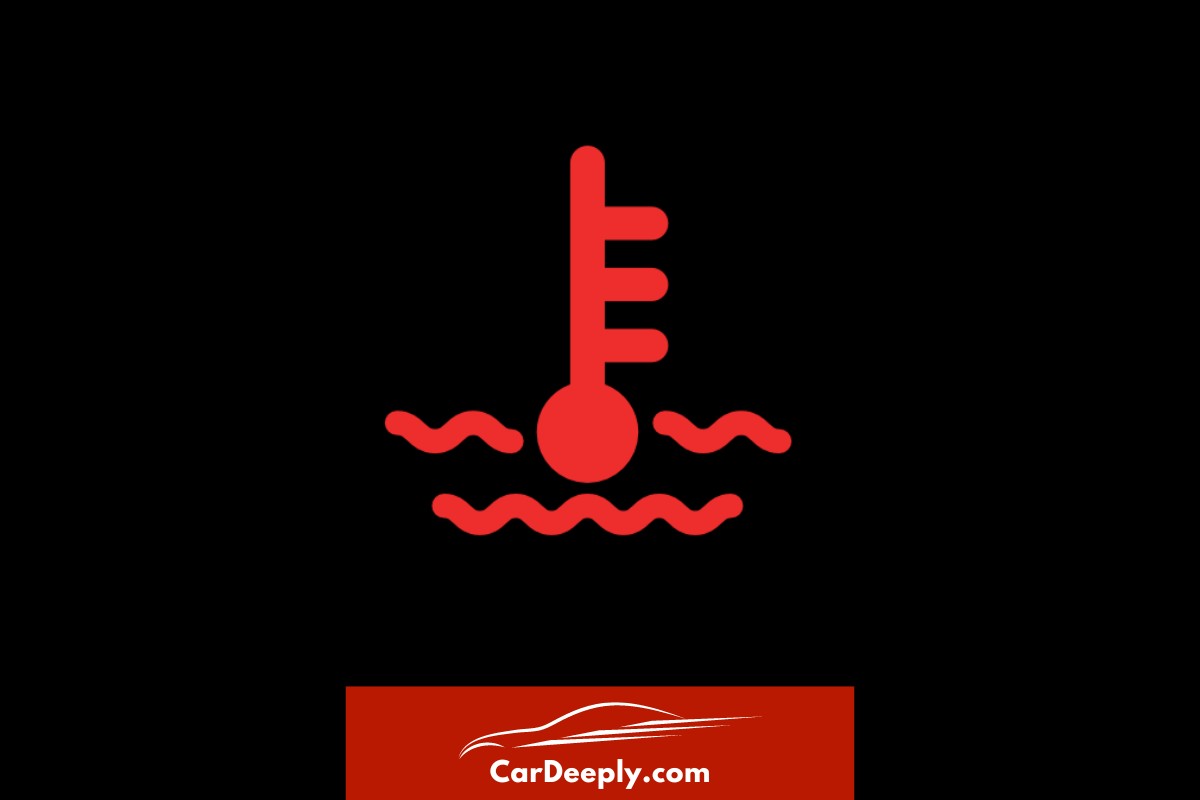
The Engine Temperature Warning Light could be described as your car’s personal fever thermometer. This light resembles a thermometer submerged in liquid or a temperature gauge icon.
It warns you when your engine is overheating.
Possible causes for the Engine Temperature Warning Light
- Low coolant level: The coolant might need a top-up.
- Stuck thermostat: The thermostat isn’t regulating temperature correctly.
- Radiator issues: The radiator could be clogged or leaking.
- Faulty water pump: Poor coolant circulation due to a failing water pump.
- Cooling fan failure: The fan responsible for cooling the engine isn’t working.
Correct behavior in case of a Engine Temperature Warning Light
- Pull over safely and turn off the engine. Overheating can lead to expensive damage.
- Allow the motor to cool down. Don’t open the hood just yet; it’s hot in there!
- Once it’s cooled, check the coolant level. If it’s low, refill it with the right mix.
- If the coolant level is acceptable or the light comes back on, call your favorite mechanic for help.
Your car’s engine is a finely tuned machine, and extreme temperatures can be its nemesis. So keep an eye on that Engine Temperature Warning Light and act swiftly to avoid costly repairs.
#3: Battery Alert
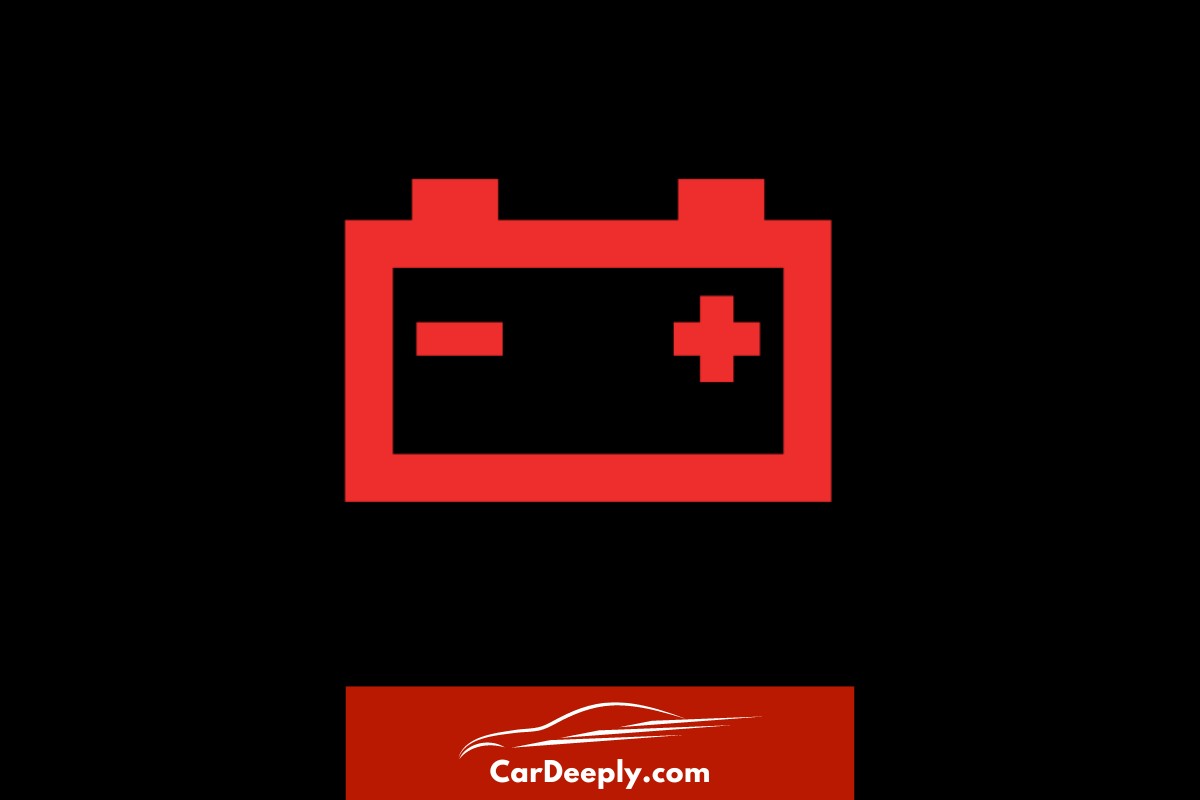
The Battery Alert is the guardian of your car’s electrical power source!
This light often resembles a battery icon and warns you of an issue with your car’s charging system.
Possible causes for the Battery Alert
- Faulty alternator: The alternator isn’t charging the battery correctly.
- Loose or damaged belts: The alternator’s belts might slip or break.
- Lousy battery: Your battery could fail or not hold a charge.
- Corroded or loose connections: Poor electrical connections might be hindering the charge.
Correct behavior in case of a Battery Alert
- Find a safe place to pull over, and turn off any unnecessary electrical accessories.
- Do not turn off if your car is running!
- Inspect the belts for visible damage, but be cautious around moving parts.
- If you can’t spot the issue or the light stays on, it’s time to call a mechanic or a tow truck.
Remember, your car’s battery is like its electrical lifeline, and the Battery Alert is here to ensure everything’s running smoothly.
#4: Seat Belt Reminder
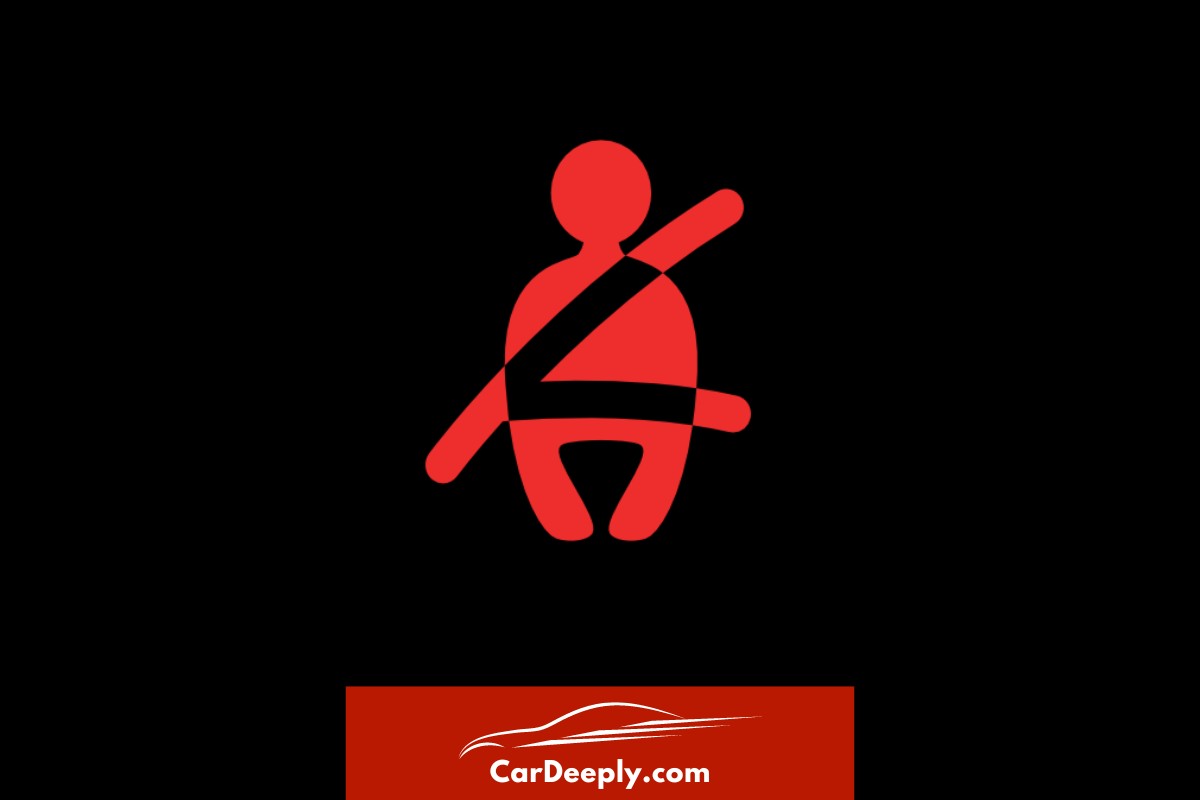
We are introducing the Seat Belt Reminder, your car’s friendly nudge to buckle up for safety.
This light usually looks like a seated person with a seat belt across their chest, and it’s here to remind you and your passengers to fasten those seat belts.
Possible causes for the Seat Belt Reminder
- Unbuckled seat belt: You or one of your passengers might have yet to fasten the seat belt.
- Faulty seat belt sensor: The sensor detecting the seat belt’s status could malfunction.
- Damaged seat belt: The seat belt itself might be worn or damaged, affecting its function.
When the Seat Belt Reminder comes on, here’s what to do:
- Don’t worry – let’s make sure everyone’s safe!
- Check that you and all passengers have securely fastened their seat belts.
- If a seat belt is stuck or damaged, try to fix it or use another seating position if available.
- Should the light persist even with all seat belts fastened, consult a mechanic to inspect the sensors.
The Seat Belt Reminder is like a caring friend, always looking out for your safety. Pay attention to it, buckle up, and enjoy a safer ride on the road!
#5: Airbag Indicator Light

Meet the Airbag Warning, the watchful eye of your car’s airbag system.
This light often resembles a seated passenger with an airbag deploying and alerts you to potential issues with your vehicle’s airbags.
Possible causes for the Airbag Indicator Light
- Faulty airbag sensor: One or more sensors monitoring the airbags could malfunction.
- Airbag system malfunction: There might be an issue within the airbag system, such as wiring or module problems.
- Broken clock spring: The clock spring in the steering wheel, responsible for maintaining electrical connections, could be faulty.
Correct behavior in case of an Airbag Indicator Light
- If the light flickers or comes on intermittently, try turning off the engine and restarting it. This might reset the system.
- If the light remains on, drive cautiously to your nearest mechanic for a proper diagnosis.
- Avoid attempting DIY fixes on airbag systems, as this can be dangerous.
Always pay attention to this light, as functioning airbags can make all the difference in an accident.
#6: Security Indicator
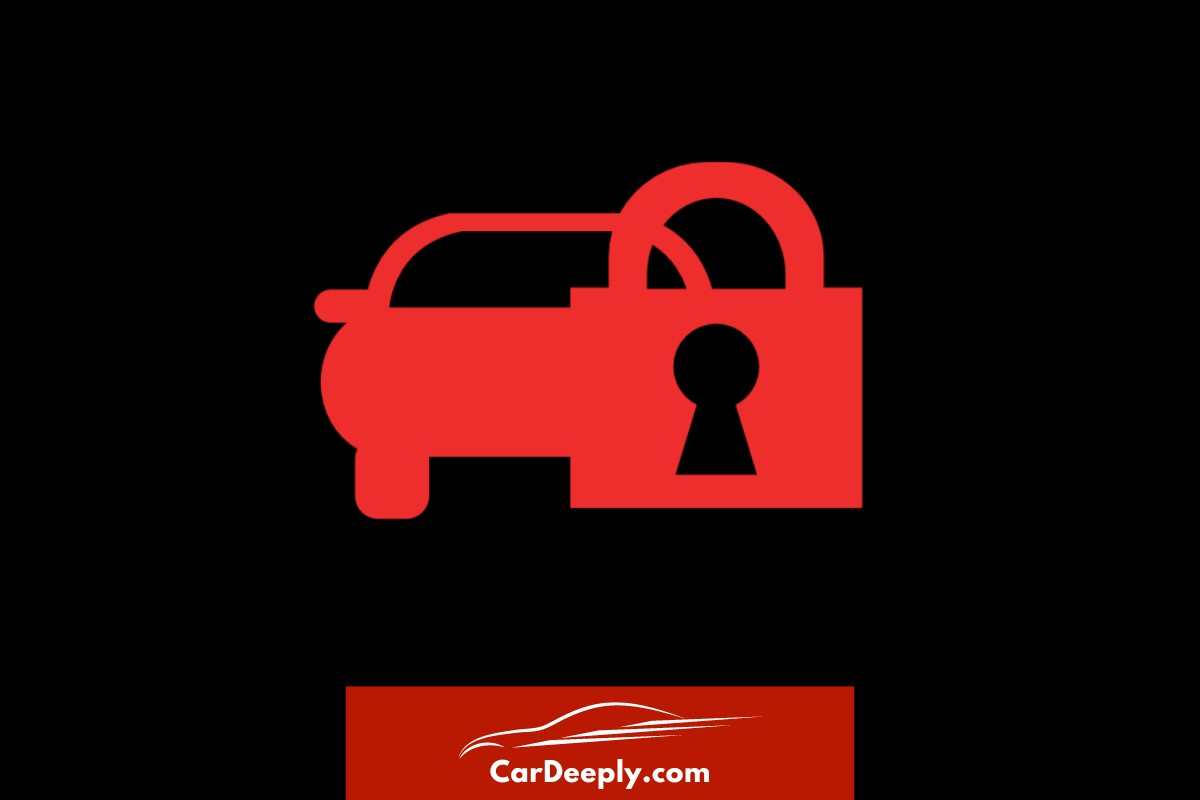
The Security Indicator is like the vigilant protector of your car’s anti-theft system.
This light often resembles a car with a padlock, and it lets you know about any issues with your vehicle’s security features.
Possible reasons for the Security Indicator:
- Faulty key or fob: The key or fob you’re using might not be recognized by the car’s system.
- Anti-theft system malfunction: An issue with the immobilizer or alarm could be triggering the light.
- Wiring or sensor problems: Electrical issues could be affecting the security system’s performance.
Here’s what to do:
- If the light comes on while driving, make sure you’re using the correct key or fob.
- In case the light is still on with the right key or fob, try turning off the engine and restarting the car to see if it resets the system.
- If the issue persists, reach out to your trusty mechanic for an expert diagnosis.
#7: Brake Warning Light
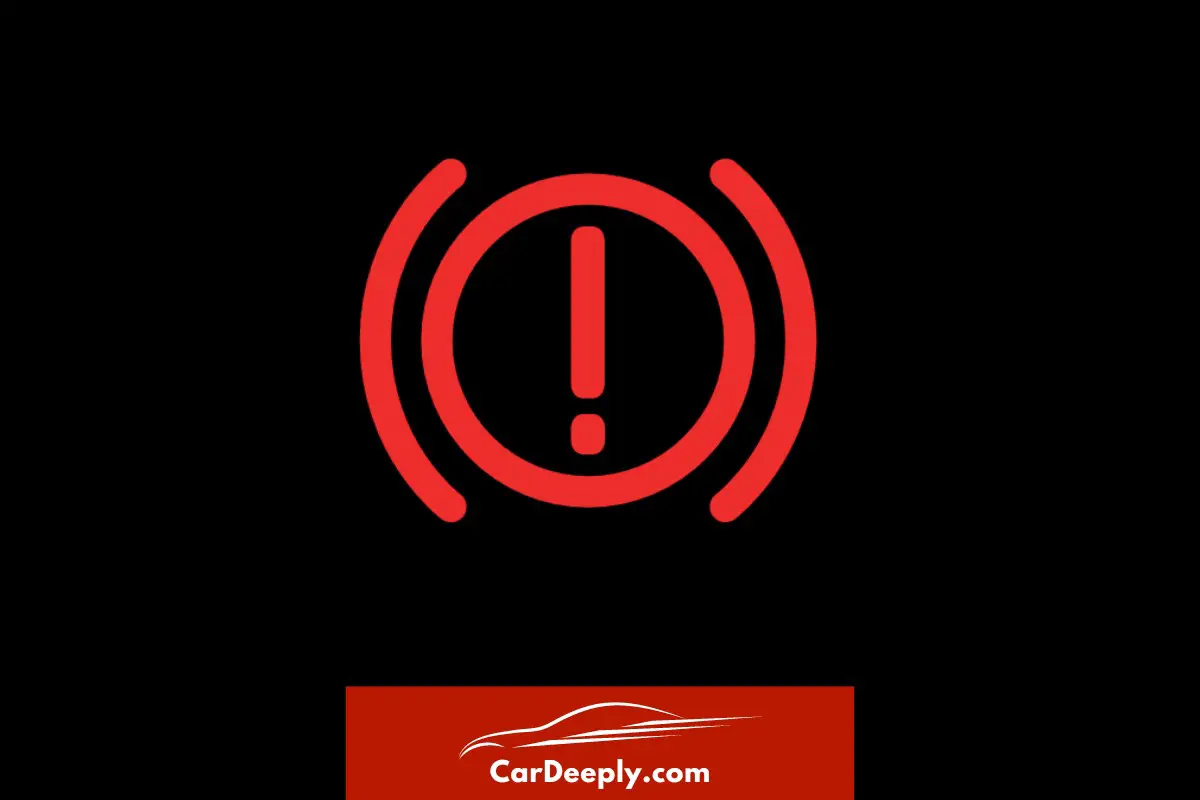
Welcome the Brake Warning Light, your car’s trusty advisor on all things braking!
This light usually displays as an exclamation mark inside a circle or parentheses and warns you about potential issues with your vehicle’s braking system.
Possible causes for the Brake Warning Light
- Low brake fluid: The brake fluid reservoir might need topping up.
- Worn brake pads: Your brake pads could be due for replacement.
- Faulty brake sensor: The sensor monitoring the brakes could be malfunctioning.
- Parking brake engaged: You might have forgotten to disengage the parking brake.
Correct behavior when the Brake Warning Light is activated:
- Check if the parking brake is engaged. If it is, release it and see if the light goes off.
- If the light stays on, find a safe place to pull over and inspect the brake fluid level. If it’s low, add the recommended fluid.
- Should the light continue to shine, it’s time to visit your reliable mechanic for a brake system checkup.
The Brake Warning Light is like a dedicated mentor, keeping your car’s braking system in check. Pay attention to its signals, and you’ll ensure a safe and smooth stopping experience on the road!
#8: Transmission Temperature Warning Light
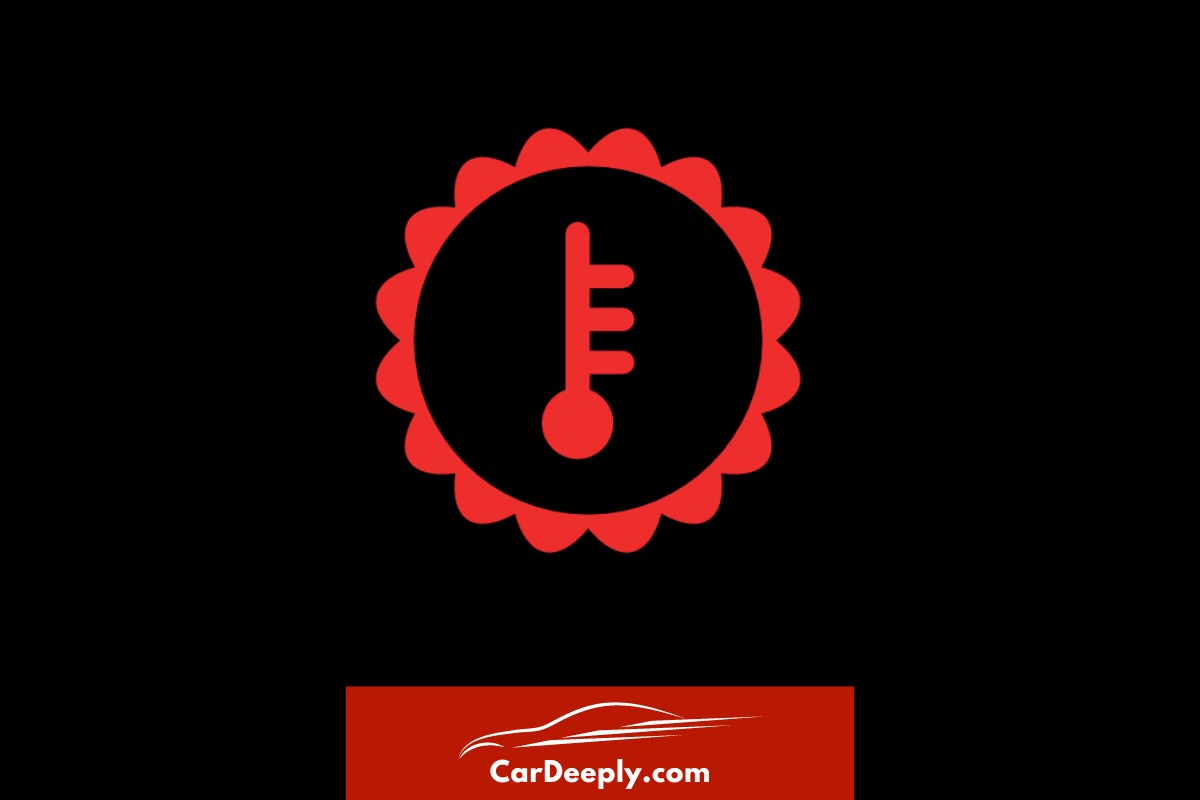
Introducing the Transmission Temperature Warning Light, the trusty sentinel of your car’s transmission! This light often looks like a thermometer with gear-like shapes and alerts you when your vehicle’s transmission is overheating.
Possible causes for the Transmission Temperature Warning Light
- Low transmission fluid: The fluid level might be too low, causing the transmission to overheat.
- Old or dirty fluid: Worn-out or contaminated fluid can hinder the transmission’s cooling ability.
- Clogged transmission cooler: The cooler responsible for maintaining the transmission’s temperature could be obstructed.
- Heavy towing or driving conditions: Prolonged extreme driving conditions can overheat the transmission.
Correct behavior when the Transmission Temperature Warning Light pops up
- Find a safe place to pull over, and let your engine idle for a few minutes to help cool down the transmission.
- Check the transmission fluid level and condition. If it’s low or dirty, refill or replace it as needed.
- If the light remains on or reappears frequently, consult your go-to mechanic for a thorough inspection.
The Transmission Temperature Warning Light is like a dedicated custodian, ensuring your car’s transmission stays cool and functional. Heed its warning, and you’ll keep your transmission in tip-top shape for the long haul!
#9: Power Steering Warning Light
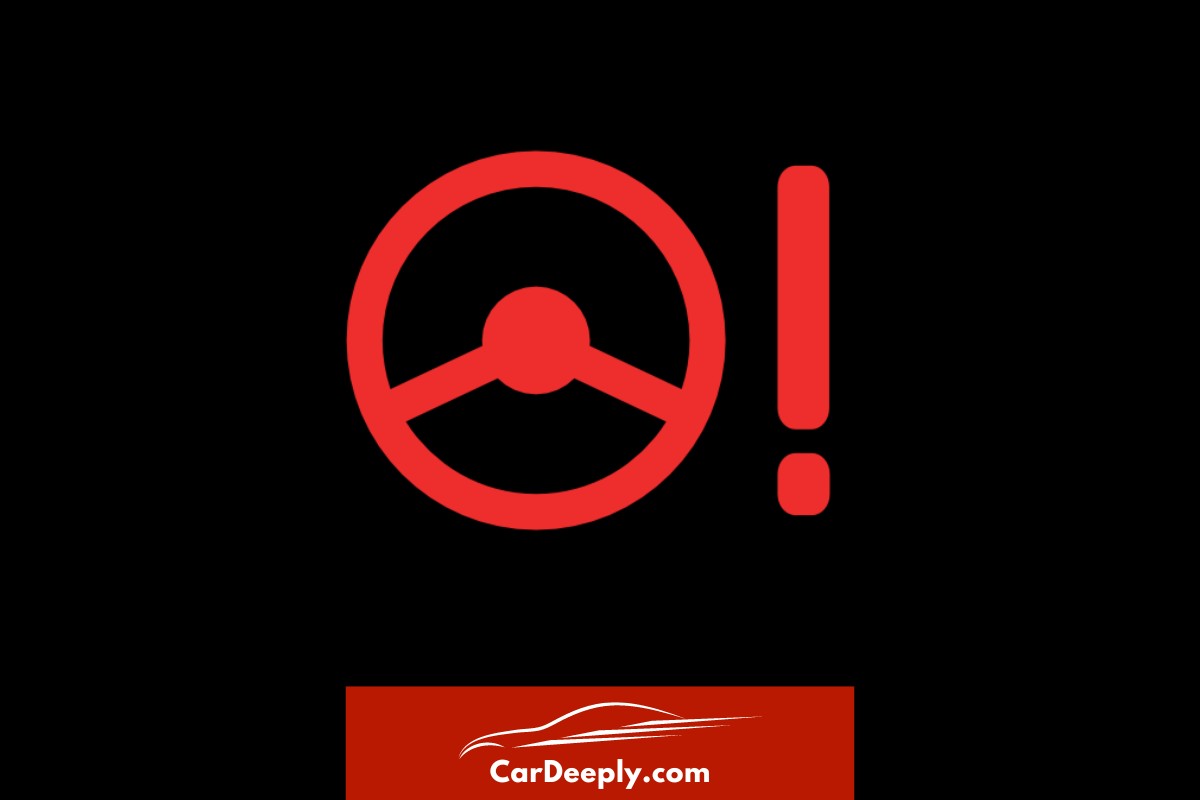
Give a warm welcome to the Power Steering Warning Light, the vigilant guardian of your car’s power steering system! This light typically displays as a steering wheel icon with an exclamation mark and warns you of potential issues with your vehicle’s power steering.
Possible causes for the Power Steering Warning Light
- Low power steering fluid: The fluid level might be too low, affecting the steering system’s performance.
- Power steering pump failure: The pump responsible for circulating fluid may be malfunctioning.
- Damaged or loose belts: Belts driving the power steering pump could be slipping or broken.
- Faulty steering rack: The steering rack, which helps turn the wheels, might be failing.
Correct behavior when the Power Steering Warning Light comes on
- Safely pull over and check the power steering fluid level. If it’s low, top it off with the appropriate fluid.
- Inspect the belts for visible damage, taking care around any moving parts.
- If the light persists or you can’t find the issue, head to your trusted mechanic for a professional assessment.
The Power Steering Warning Light is like a reliable companion, ensuring your car’s steering system stays in optimal condition.
#10: Tire Pressure Warning Light
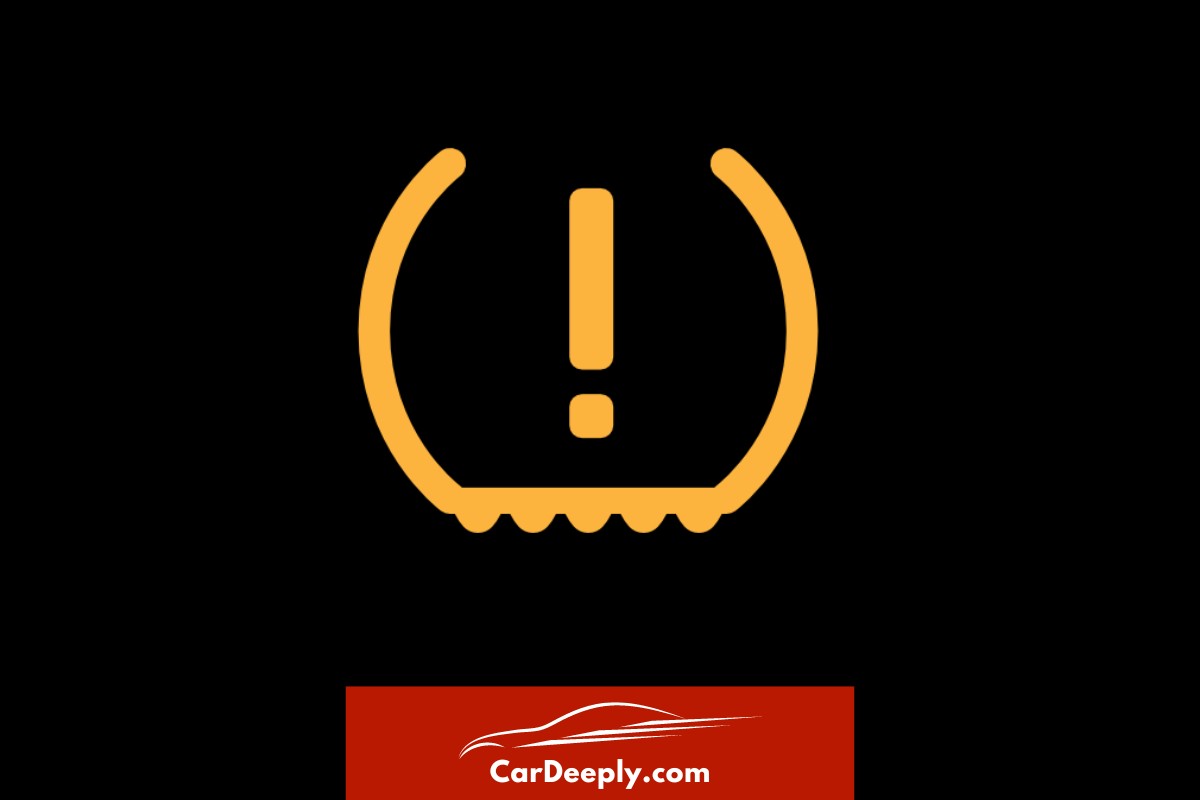
Say hello to the Tire Pressure Warning Light, the ever-watchful guardian of your car’s tire pressure! This light typically resembles a cross-section of a tire with an exclamation mark inside and alerts you when the tire pressure is outside the recommended range.
Possible causes for the Tire Pressure Warning Light:
- Low tire pressure: One or more tires might be underinflated, affecting your vehicle’s performance.
- Overinflated tire: A tire could be overinflated, increasing the risk of a blowout.
- Faulty tire pressure sensor: The sensor monitoring tire pressure may be malfunctioning.
- Seasonal temperature changes: Fluctuating temperatures can cause tire pressure to vary (very common).
When the Tire Pressure Warning Light shows up, follow these steps:
- At your earliest convenience, stop and visually inspect your tires for any visible damage or deflation.
- Use a tire pressure gauge to check the pressure of each tire and inflate or deflate them to the recommended PSI.
- If the light doesn’t go off after adjusting the pressure, or if it comes on frequently, consult your reliable mechanic for a checkup.
The tire pressure monitoring system is like a steadfast friend, ensuring your tires are always in prime condition. By paying attention to its signals, you’ll enjoy a safer and more fuel-efficient ride on the road!
#11: Traction Control Light
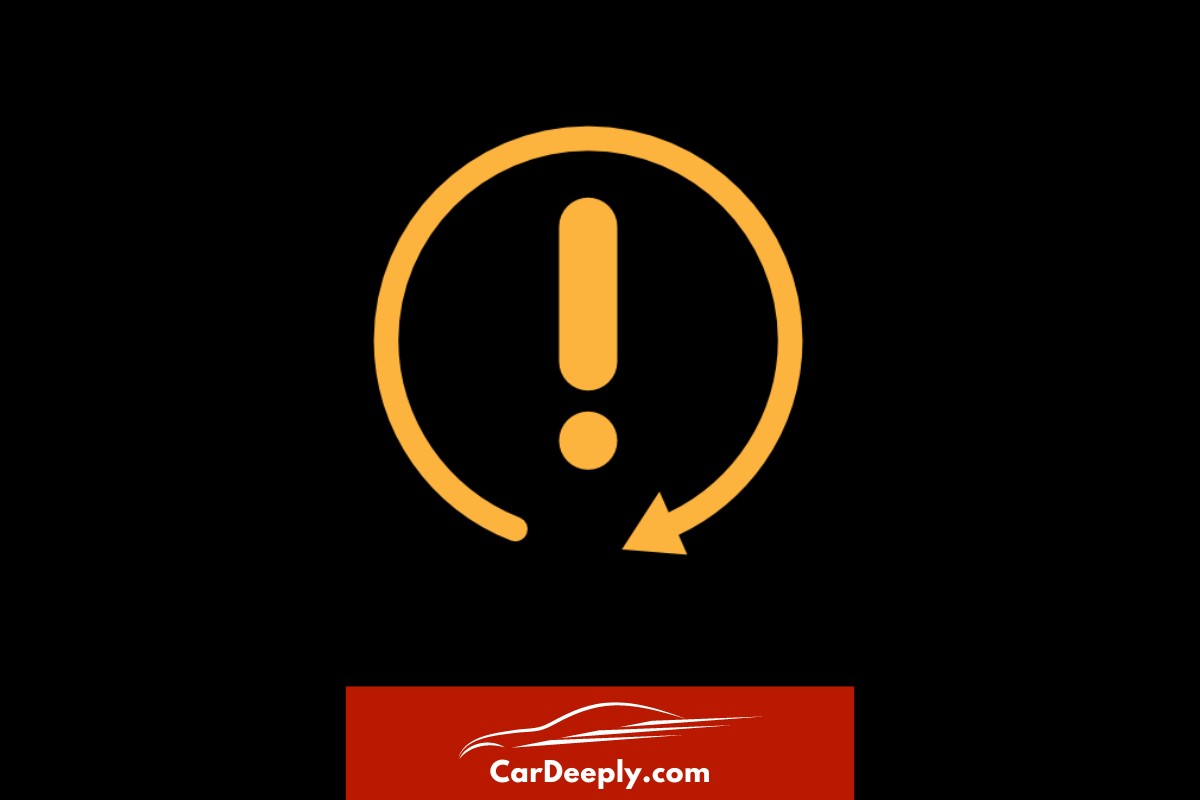
Introducing the Traction Control Light, the steadfast guardian of your car’s grip on the road! This light typically resembles a car skidding or a car with wavy tire tracks and alerts you when your vehicle’s traction control system is engaged or experiencing an issue.
Possible causes for the Traction Control Light
- Traction control activation: The system is temporarily activated to help maintain grip during slippery driving conditions.
- Faulty wheel speed sensor: The sensor responsible for monitoring wheel speed might be malfunctioning.
- Damaged wiring: The wiring connecting the traction control system could be compromised.
- Worn or mismatched tires: Tires in poor condition or with uneven wear can affect the traction control system.
When the Traction Control Light comes on, here’s what to do:
- If the light comes on briefly during acceleration or cornering on a slippery surface, it’s likely just the system doing its job. Carry on with caution.
- If the light remains on or comes on frequently, find a safe place to pull over and inspect your tires for any visible issues or uneven wear.
- Should the light continue to stay on, schedule a visit to your go-to mechanic for a thorough inspection.
The Traction Control Light is like a trusty ally, ensuring your car maintains a firm grip on the road when it matters most.
#12: Anti-lock Braking System (ABS) Warning Light
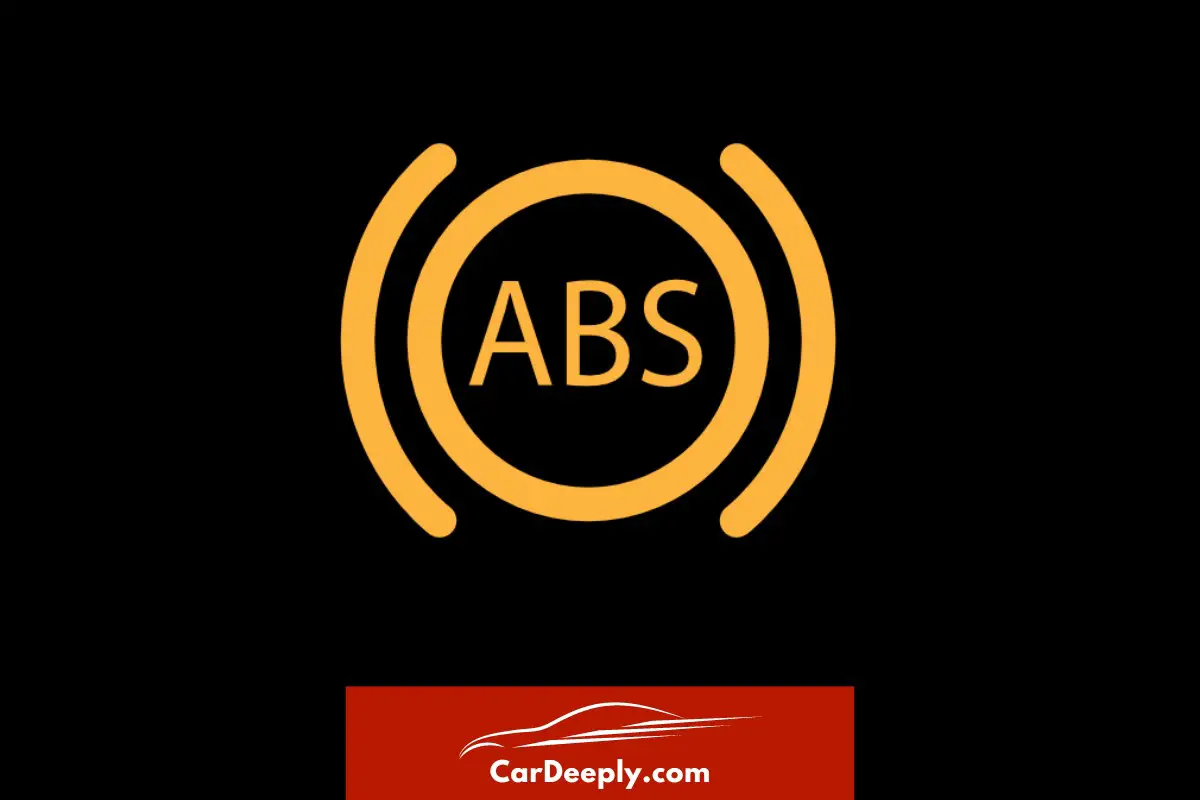
Give a warm welcome to the ABS Warning Light, the vigilant protector of your car’s anti-lock braking system! This light typically displays as “ABS” or a circle with a broken circle around it and warns you of potential issues with your vehicle’s ABS.
Possible causes for the ABS Warning Light
- Faulty ABS sensor: One or more sensors monitoring the wheel speed could be malfunctioning.
- Damaged wiring: The wiring connecting the ABS system might be compromised.
- Low brake fluid: The brake fluid reservoir might need topping up.
- Malfunctioning ABS module: The ABS control unit could be experiencing an issue.
When the ABS Warning Light appears, here’s your course of action:
- Remember that, even if your ABS isn’t working, your regular brakes should still function. Drive cautiously and avoid sudden stops if possible.
- Find a safe place to pull over and check the brake fluid level. If it’s low, add the recommended fluid.
- If the light stays on or comes on frequently, it’s time to visit your trusted mechanic for a professional ABS inspection.
Do you drive a Ford F-150? Find here the solution of an ABS light for your vehicle.
#13: Check Engine Light
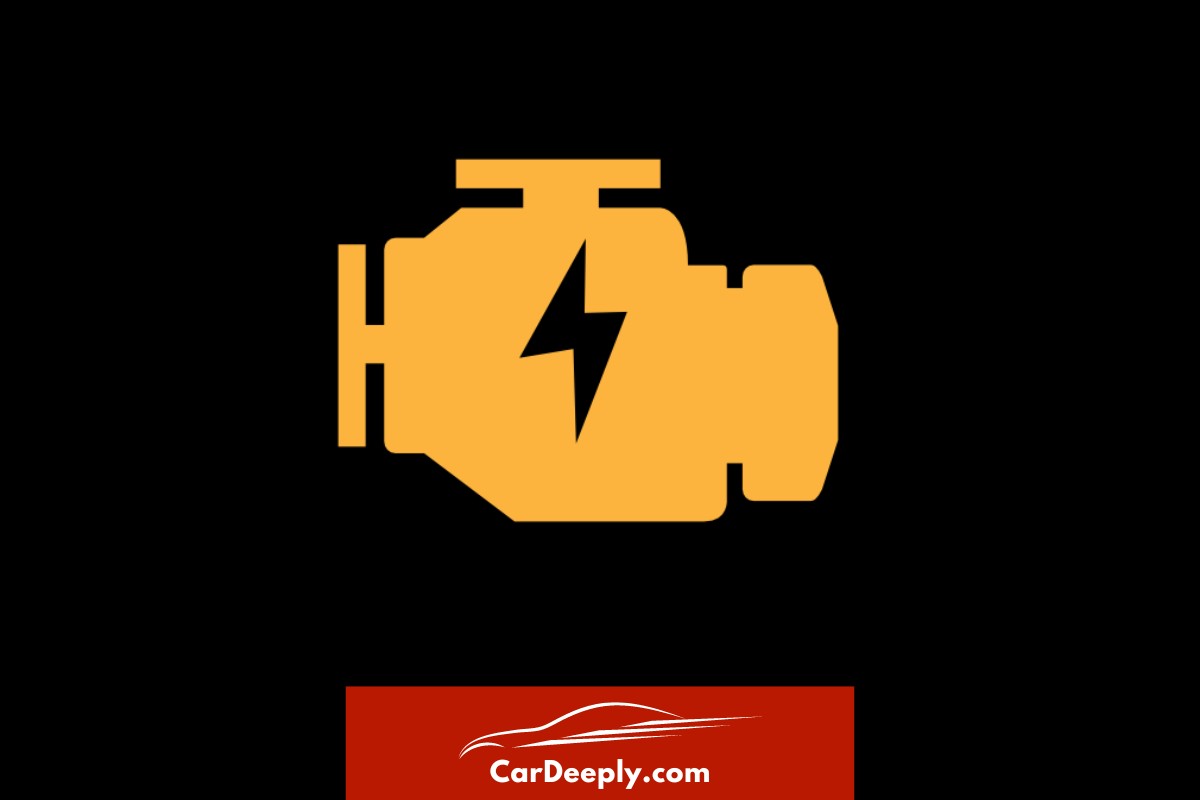
The Check Engine Light is the most enigmatic and notorious guardian of your car’s overall health!
When it shows on the dashboard, there is something wrong with your car!
This light typically displays as an engine icon or the words “Check Engine” and can signal anything from a minor issue to a major problem with your vehicle’s engine or other components.
Possible causes for the Check Engine Light (varying from minor to major)
- Loose or missing gas cap: If the gas cap isn’t properly tightened or is missing, fuel vapors can escape, causing the light to come on.
- Faulty oxygen sensor: A malfunctioning sensor can affect your car’s fuel mixture and efficiency.
- Failing catalytic converter: A damaged converter can reduce your vehicle’s performance and increase emissions.
- Misfiring spark plugs: Worn or malfunctioning spark plugs can cause your engine to run poorly.
- Mass airflow sensor issue: A faulty sensor can lead to incorrect fuel delivery and poor engine performance.
- Malfunctioning ignition coil: A failing coil can cause misfires and hinder your engine’s smooth operation.
When the Check Engine Light appears, follow these steps:
- Check for any obvious issues, like a loose gas cap, and tighten or replace it if necessary.
- If the light is blinking, it indicates a more severe issue that could damage the catalytic converter. Reduce speed and avoid heavy acceleration, then head to your mechanic as soon as possible.
- If the light is steady, having your vehicle checked by a trusted mechanic is still important, but you may have more time to schedule a visit.
Want to learn more about check engine light? See our post!
#14: Low Fuel Indicator
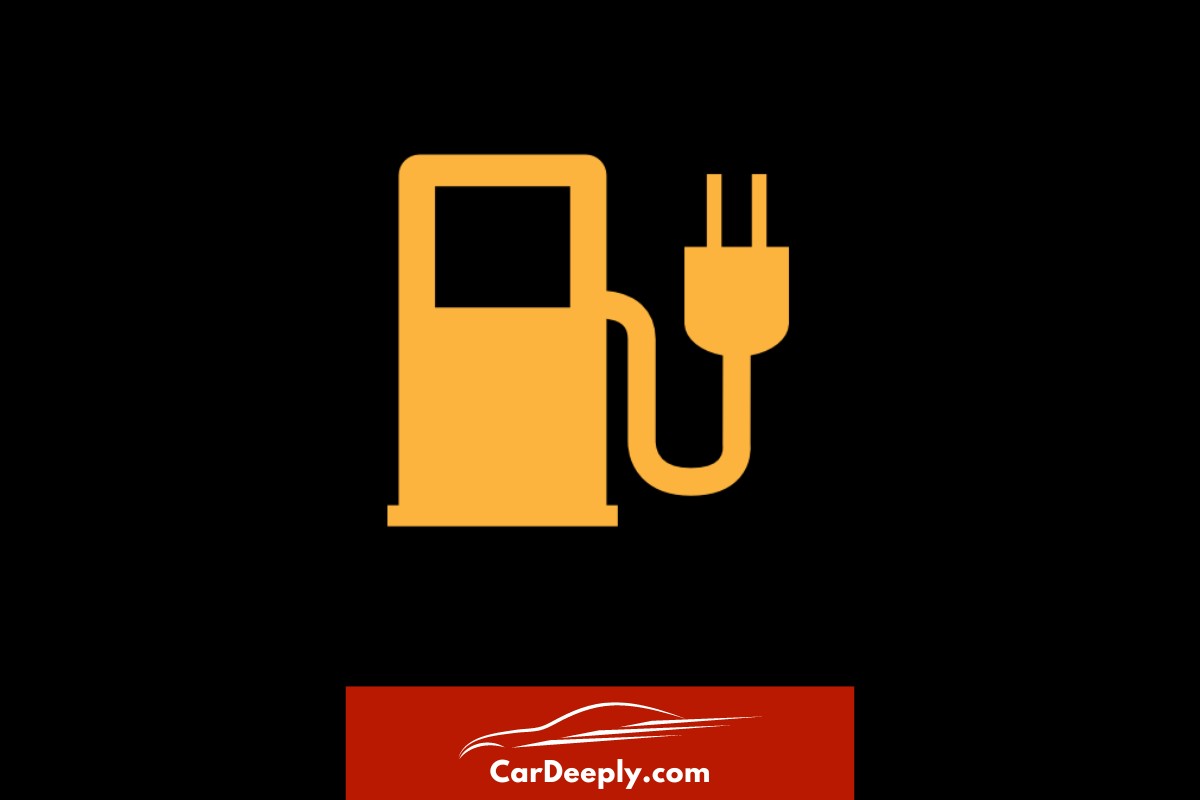
Low Fuel Indicator, your car’s trusty reminder to refuel, and one of the most harmless dashboard warning lights.
This light usually looks like a gas pump or fuel canister and lets you know when your vehicle is running low on fuel.
Possible causes for the Low Fuel Indicator
- Low fuel level: Your car’s fuel tank is running low and needs to be refilled.
- Faulty fuel level sensor: The fuel level sensor could malfunction.
What to do when the Low Fuel Indicator light on your dashboard
- If you haven’t filled up recently, your fuel tank is likely running low. Start looking for a gas station nearby.
- Remember that constantly driving with a low fuel level can cause damage to your fuel pump, so it’s best to refuel sooner rather than later.
- If you’ve recently refueled and the light persists, it could be an issue with the fuel level sensor. Schedule a visit to your go-to mechanic for a thorough inspection.
#15: Washer Fluid Light
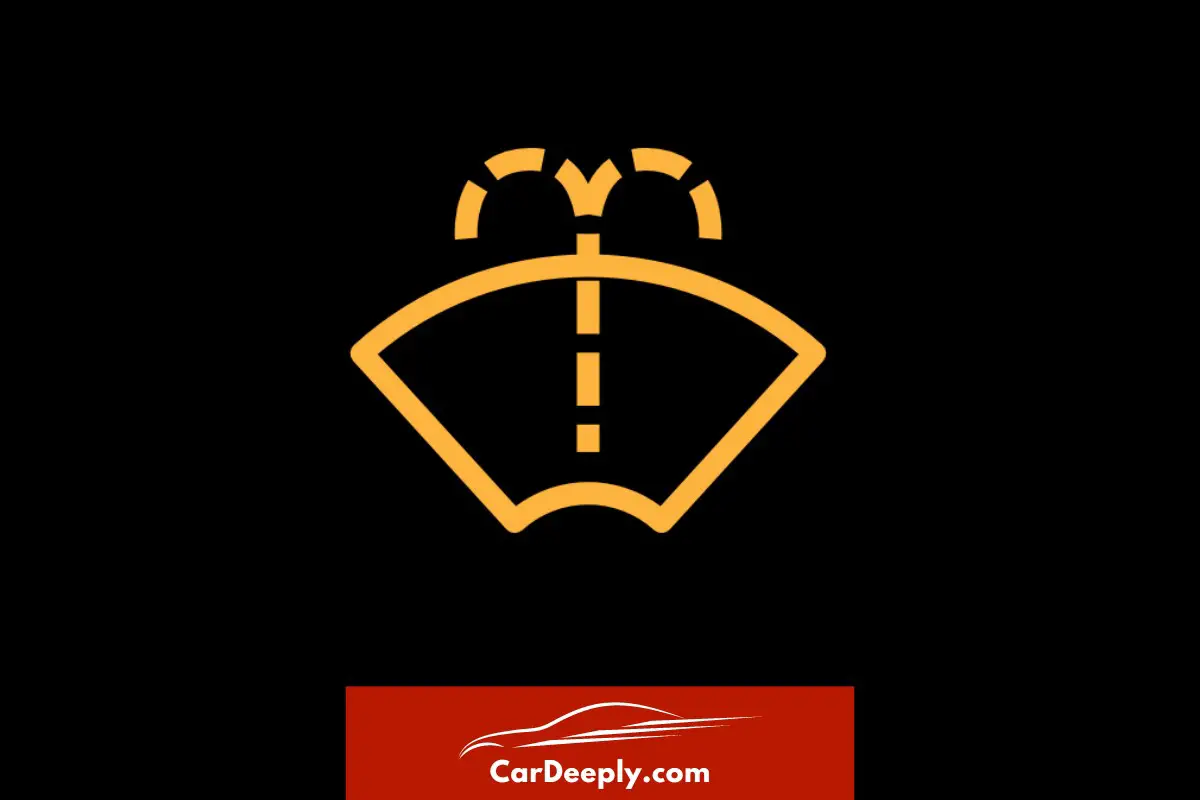
Introducing the Washer Fluid Light, the attentive caretaker of your car’s windshield washing system.
This light typically resembles a windshield with a water spray or a wavy water icon and lets you know when your vehicle’s washer fluid reservoir is running low.
Possible causes for the Washer Fluid Light
- Low washer fluid level: Your car’s washer fluid reservoir needs to be refilled.
- Faulty washer fluid level sensor: The sensor monitoring the washer fluid level could malfunction.
When the Washer Fluid Light comes on, here’s your plan of action
- When it’s convenient, check the washer fluid reservoir and top it off with the appropriate fluid if necessary. Make sure to use a fluid suited for your climate, as some are specifically designed for colder temperatures.
- Once refilled, the light should go off. Test the windshield washer system to ensure it’s functioning correctly.
- If the light remains on after refilling or comes on frequently, consult your mechanic for a possible sensor issue or a leak in the system.
The Washer Fluid Light is like a thoughtful companion, making sure you always have a clear and unobstructed view of the road ahead. By paying attention to its signals, you’ll maintain excellent visibility and drive safely, no matter the weather conditions!
#16: Lane Departure Light
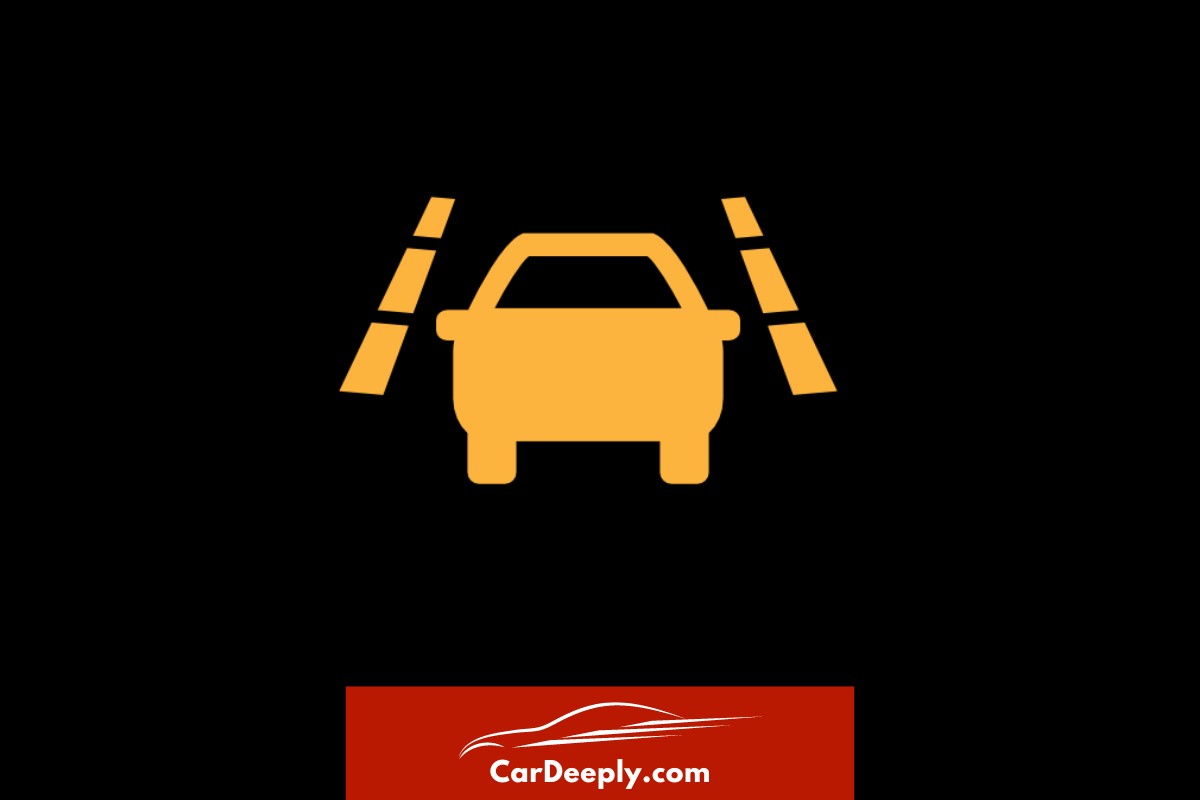
Welcome the Lane Departure Warning, the watchful guardian of your car’s position on the road!
This light typically looks like a car between two parallel lines or a car veering off a lane, and it alerts you when your vehicle unintentionally drifts out of its lane without signaling.
Possible causes for the Lane Departure Light
- Unintentional lane departure: Your car has detected that it’s straying from its lane without a turn signal.
- Malfunctioning sensors or cameras: The system responsible for monitoring lane markings might be experiencing an issue.
When the Lane Departure Light comes on, follow these steps
- If the light activates when you unintentionally drift from your lane, gently steer your car back into the proper position, being mindful of surrounding traffic.
- If the light comes on frequently or remains on, ensure that the sensors or cameras are clean and unobstructed. Dirt, snow, or debris can interfere with their function.
- If the issue persists after cleaning, visit your trusted mechanic for a thorough inspection of the lane departure system.
#17: Water in Filter Warning
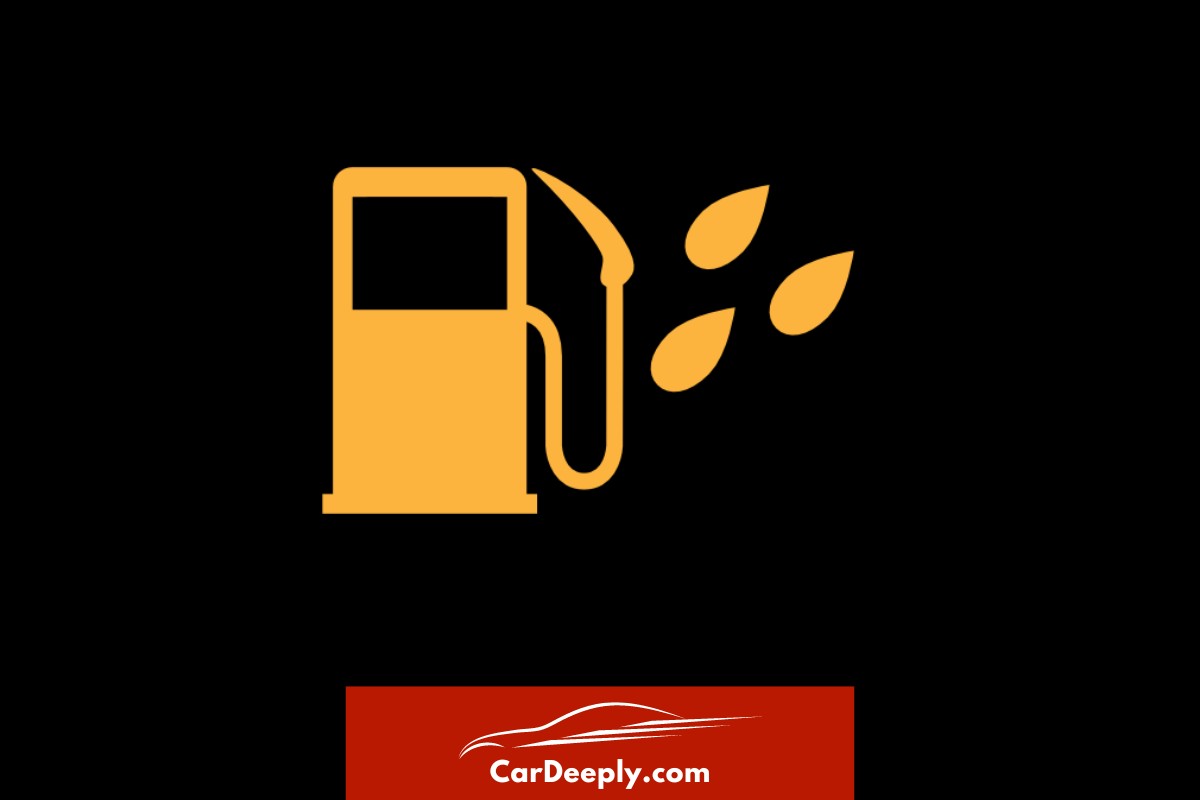
This light typically appears as a water droplet or fuel filter icon and alerts you when there’s water detected in your vehicle’s fuel filter.
Possible causes for the Water in Filter Warning
- Water contamination: Your car’s fuel filter has detected water mixed in with the fuel, which can lead to engine problems.
- Faulty fuel filter sensor: The sensor responsible for monitoring water contamination in the fuel filter may be malfunctioning.
When the Water in Filter Warning appears on your dashboard
- Safely pull over as soon as possible and turn off the engine. Continuing to drive with water in the fuel filter can cause severe engine damage.
- Consult your vehicle’s owner’s manual to locate the water separator drain valve, typically found near the fuel filter.
- Carefully open the drain valve to release the water. Be cautious, as fuel might also be released. Close the valve once the water is drained.
- If the light persists or frequently reappears, it’s time to visit your trusted mechanic for a professional assessment of your fuel system.
#18: Traction Control Malfunction Light
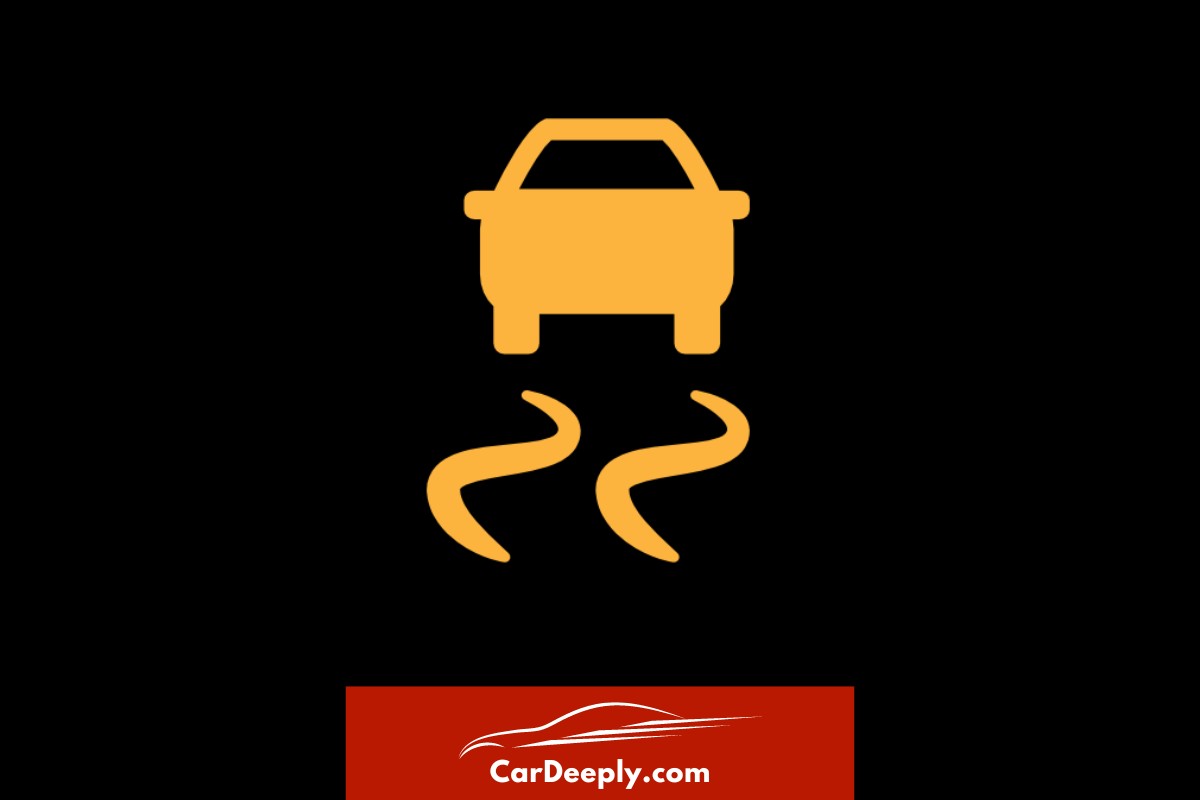
This light typically resembles a car skidding or a car with wavy tire tracks, accompanied by an “OFF” or “MALFUNCTION” indicator, and alerts you when there’s an issue with your vehicle’s traction control system.
Possible causes for the Traction Control Malfunction Light
- Faulty wheel speed sensor: The sensor responsible for monitoring wheel speed might be malfunctioning.
- Damaged wiring: The wiring connecting the traction control system could be compromised.
- Worn or mismatched tires: Tires in poor condition or with uneven wear can affect the traction control system.
- Malfunctioning control module: The traction control module could be experiencing an issue.
When the Traction Control Malfunction Light appears, here’s what to do:
- Your vehicle’s traction control system may not be operational, so drive cautiously, especially in slippery conditions.
- Find a safe place to pull over and inspect your tires for any visible issues or uneven wear.
- If the light stays on or comes on frequently, schedule a visit to your go-to mechanic for a thorough inspection of the traction control system.
#19: Brake Pad Warning
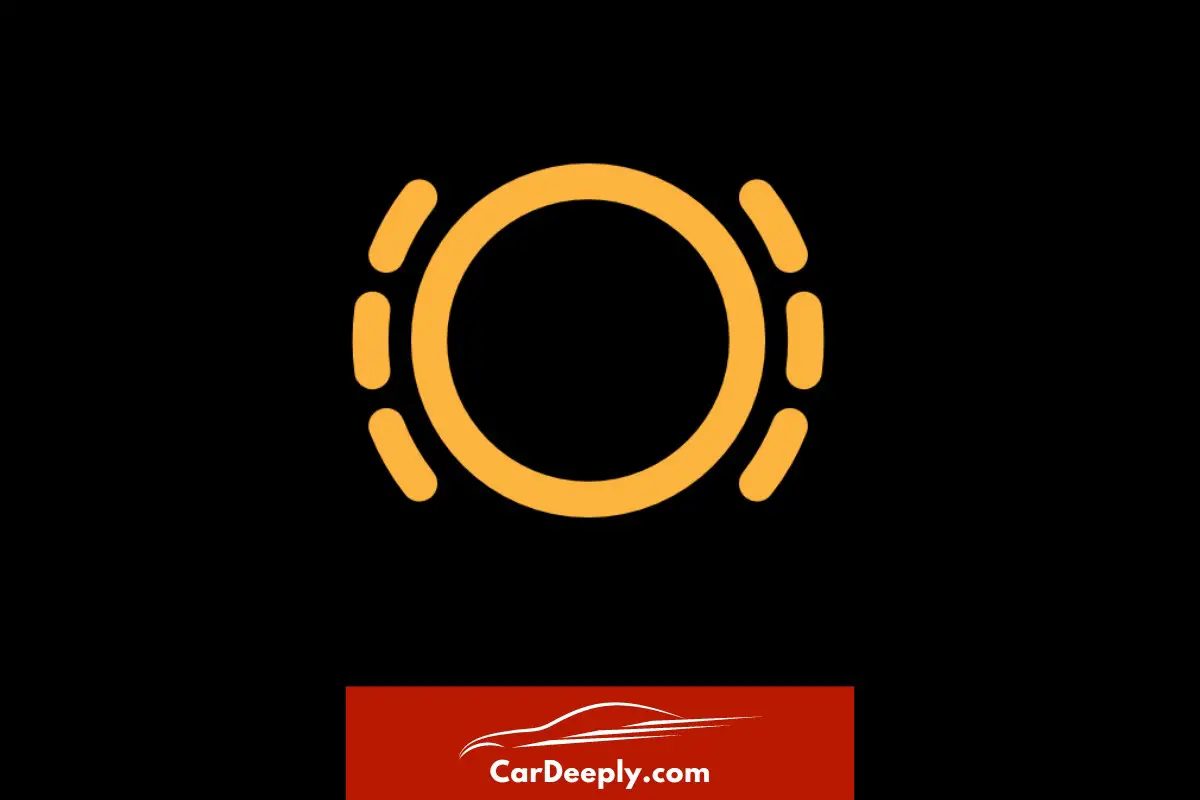
This light typically appears as a circle with several dashed lines around it or as an exclamation point surrounded by a circle with parentheses, and it alerts you when your vehicle’s brake pads are wearing thin and need replacement.
Possible causes for the Brake Pad Warning
- Worn brake pads: Your car’s brake pads have reached the end of their lifespan and require replacement.
- Faulty brake pad sensor: The sensor responsible for monitoring brake pad wear might be malfunctioning.
When the Brake Pad Warning comes on, here’s your plan of action:
- As soon as it’s convenient, visually inspect your brake pads for signs of excessive wear. You can usually see the pads through your car’s wheel spokes.
- If you’re unsure about the condition of your brake pads, consult a trusted mechanic for a professional assessment.
- Schedule a brake pad replacement as soon as possible to ensure the continued safety and performance of your braking system.
- If the light persists after replacing the brake pads, it could indicate an issue with the brake pad sensor, and you should have it checked by your mechanic.
Why do the dashboard warning symbols have different colors?
Dashboard warning symbols come in different colors to indicate the urgency and severity of the issue they’re signaling. The colors help drivers quickly understand the level of attention required and prioritize their actions accordingly. Generally, there are three main colors for dashboard warning symbols:
Red car warning lights
Red warning lights indicate a serious or urgent issue that requires immediate attention.
These symbols typically relate to critical vehicle systems, such as engine temperature, oil pressure, or braking systems.
When you see a red warning light, you should pull over and address the problem as soon as possible to avoid potential damage to your vehicle or risk your safety on the road.
Yellow/Orange warning lights
Yellow or orange warning lights signal a less urgent but still important issue.
These symbols often represent issues with the vehicle’s performance, emissions, or maintenance requirements, such as a check engine light or low tire pressure.
When a yellow or orange warning light appears, you should investigate and address the issue at your earliest convenience to prevent potential complications or further damage to your vehicle.
Green/Blue dashboard lights
Green or blue warning lights are typically informational and indicate that a specific system or feature is active or functioning properly.
Examples include the high-beam headlights indicator or the cruise control indicator. These lights are not usually cause for concern but help you stay aware of the systems currently in use.
Can I drive with a warning light?
It depends on the warning light.
If it’s a red light, you should pull over and address the issue immediately, as it signals a severe problem.
For yellow or orange lights, you can often drive with caution, but get the issue checked out as soon as possible.
The following table will help you to better orient yourself:
Warning Light | Driveable? | Need to Visit a Mechanic? |
|---|---|---|
Oil Pressure Warning Light | No | Yes |
Engine Temperature Warning Light | Yes | Yes |
Battery Alert | Yes | Yes |
Seat Belt Reminder | Yes | No |
Airbag Indicator Light | No | Yes |
Security Indicator | Yes | Yes |
Brake Warning Light | No | Yes |
Transmission Temperature Warning Light | Yes | Yes |
Power Steering Warning Light | Yes | Yes |
Tire Pressure Warning Light | Yes | Yes |
Traction Control Light | Yes | Yes |
Anti-lock Breaking System Warning Light | Yes | Yes |
Check Engine Light | Yes | Yes |
Low Fuel Indicator | Yes | No |
Washer Fluid Light | Yes | No |
Frequently Asked Questions About Dashboard Symbols
What is the most important warning light in a car?
It’s difficult to single out the “most important” warning light, as many are crucial for vehicle safety and performance.
Red warning lights like the Oil Pressure Warning Light, Engine Temperature Warning Light, and Brake Warning Light are all extremely important, as they indicate serious issues that can lead to severe damage or compromised safety.
It’s essential to address any warning light promptly to ensure your vehicle remains in good working order and safe on the road.
How to reset car warning lights?
Resetting car warning lights may vary depending on the vehicle make and model.
Generally, you can try disconnecting the battery for a few minutes or using an OBD2 scanner to clear the error codes. However, it’s essential to address the underlying issue causing the warning light before resetting it.
If you’re unsure how to proceed, consult your vehicle’s owner’s manual or seek advice from a trusted mechanic to resolve the problem safely and correctly.
Why are all my dashboard warning lights on?
If all dashboard warning lights are on, it may indicate an issue with the vehicle’s electrical system. Examples are a malfunctioning alternator, a weak battery, or a problem with the instrument cluster. It could also be caused by a loose connection or a blown fuse.

Sebastian loves convertibles and drove a BMW 335i for a long time (325 hp is just a dream). Today, with two children, he is more concerned with SUVs and family-friendly vehicles. In addition to an Audi A4 Avant, he also drives a Cupra Formentor VZ – even as a family man, you can’t do without speed. Get to know Sebastian better and visit the About Us page.
Advertising links are marked with *. We receive a small commission on sales, nothing changes for you.
